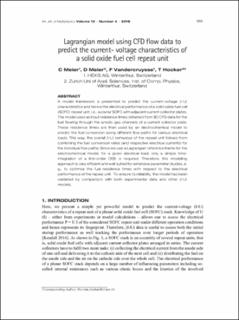Please use this identifier to cite or link to this item:
https://doi.org/10.21256/zhaw-4949| Publication type: | Article in scientific journal |
| Type of review: | Peer review (publication) |
| Title: | Lagrangian model using CFD flow data to predict the current-voltage characteristics of a solid oxide fuel cell repeat unit |
| Authors: | Meier, Christoph Meier, Daniel Vandercruysse, Felix Hocker, Thomas |
| DOI: | 10.21256/zhaw-4949 10.21152/1750-9548.12.4.393 |
| Published in: | The International Journal of Multiphysics |
| Volume(Issue): | 12 |
| Issue: | 4 |
| Page(s): | 393 |
| Pages to: | 411 |
| Issue Date: | 2018 |
| Publisher / Ed. Institution: | International Society of Multiphysics |
| ISSN: | 1750-9548 2048-3961 |
| Language: | English |
| Subjects: | SOFC; Fuel cell model |
| Subject (DDC): | 530: Physics 621.3: Electrical, communications, control engineering |
| Abstract: | A model framework is presented to predict the current-voltage (I-U) characteristics and hence the electrical performance of a solid oxide fuel cell (SOFC) repeat unit, i. e., a planar SOFC with adjacent current collector plates. The model uses as input residence times obtained from 3D CFD data for the fuel flowing through the anodic gas channels of a current collector plate. These residence times are then used by an electrochemical model to predict the fuel conversion along different flow paths for various electrical loads. This way, the overall (I-U) behaviour of the repeat unit follows from combining the fuel conversion rates (and respective electrical currents) for the individual flow paths. Since we use a Lagrangian reference frame for the electrochemical model, for a given electrical load, only a simple time-integration of a first-order ODE is required. Therefore, this modelling approach is very efficient and well suited for extensive parameter studies, e. g., to optimise the fuel residence times with respect to the electrical performance of the repeat unit. To ensure its reliability, the model has been validated by comparison with both experimental data and other (I-U) models. |
| URI: | https://digitalcollection.zhaw.ch/handle/11475/14148 |
| Fulltext version: | Published version |
| License (according to publishing contract): | CC BY 4.0: Attribution 4.0 International |
| Departement: | School of Engineering |
| Organisational Unit: | Institute of Computational Physics (ICP) |
| Appears in collections: | Publikationen School of Engineering |
Files in This Item:
| File | Description | Size | Format | |
|---|---|---|---|---|
| 2018_Meier_Lagrangian_model_using_CFD_flow_data_to_predict.pdf | 1.64 MB | Adobe PDF |  View/Open |
Show full item record
Meier, C., Meier, D., Vandercruysse, F., & Hocker, T. (2018). Lagrangian model using CFD flow data to predict the current-voltage characteristics of a solid oxide fuel cell repeat unit. The International Journal of Multiphysics, 12(4), 393–411. https://doi.org/10.21256/zhaw-4949
Meier, C. et al. (2018) ‘Lagrangian model using CFD flow data to predict the current-voltage characteristics of a solid oxide fuel cell repeat unit’, The International Journal of Multiphysics, 12(4), pp. 393–411. Available at: https://doi.org/10.21256/zhaw-4949.
C. Meier, D. Meier, F. Vandercruysse, and T. Hocker, “Lagrangian model using CFD flow data to predict the current-voltage characteristics of a solid oxide fuel cell repeat unit,” The International Journal of Multiphysics, vol. 12, no. 4, pp. 393–411, 2018, doi: 10.21256/zhaw-4949.
MEIER, Christoph, Daniel MEIER, Felix VANDERCRUYSSE und Thomas HOCKER, 2018. Lagrangian model using CFD flow data to predict the current-voltage characteristics of a solid oxide fuel cell repeat unit. The International Journal of Multiphysics. 2018. Bd. 12, Nr. 4, S. 393–411. DOI 10.21256/zhaw-4949
Meier, Christoph, Daniel Meier, Felix Vandercruysse, and Thomas Hocker. 2018. “Lagrangian Model Using CFD Flow Data to Predict the Current-Voltage Characteristics of a Solid Oxide Fuel Cell Repeat Unit.” The International Journal of Multiphysics 12 (4): 393–411. https://doi.org/10.21256/zhaw-4949.
Meier, Christoph, et al. “Lagrangian Model Using CFD Flow Data to Predict the Current-Voltage Characteristics of a Solid Oxide Fuel Cell Repeat Unit.” The International Journal of Multiphysics, vol. 12, no. 4, 2018, pp. 393–411, https://doi.org/10.21256/zhaw-4949.
Items in DSpace are protected by copyright, with all rights reserved, unless otherwise indicated.